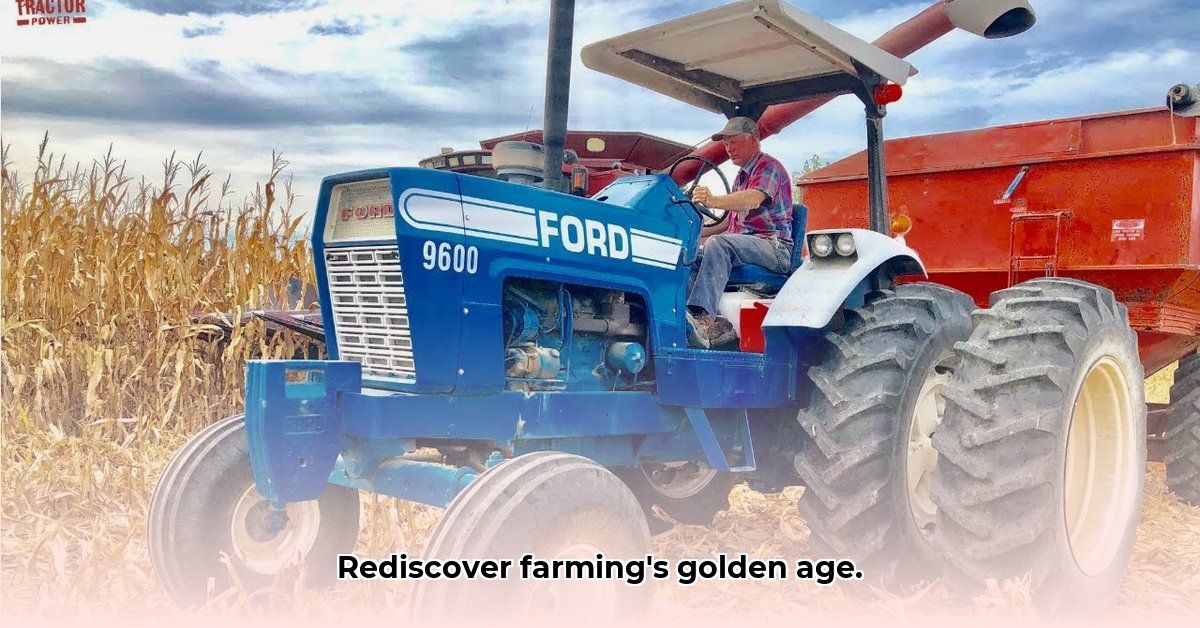
1960s Tractors: A Technological Leap Forward
The 1960s marked a pivotal era in agriculture, a period defined by the dramatic rise of powerful and efficient tractors. These weren't just machines; they were symbols of progress, fundamentally altering farming practices and the rural landscape. John Deere and International Harvester, two industry giants, spearheaded this revolution, engaging in a fierce competition that fueled innovation and reshaped the agricultural world. The result? Higher yields, reduced labor costs, and a significant shift in the socioeconomic fabric of rural America. For more on specific models, check out these 1960s Case tractors.
Did you know that the introduction of diesel engines alone dramatically increased fuel efficiency and horsepower in 1960s tractors? This simple fact represents a huge technological advancement from previous models.
The Titans of the Field: John Deere and International Harvester
The transformative power of 1960s tractors stemmed from several key advancements. The shift to powerful diesel engines provided significantly improved fuel efficiency and increased horsepower, making them far more effective than their gasoline-powered predecessors. The widespread adoption of hydraulic systems revolutionized operation, making the tractors far easier and more intuitive to control. Imagine the difference between struggling with a horse-drawn plow and effortlessly maneuvering a powerful machine across vast fields.
"The introduction of hydraulic systems was a game-changer," says Dr. Amelia Hernandez, Agricultural Historian at the University of Illinois. "It dramatically increased both the efficiency and the precision of farming operations."
This wasn't simply about brute force; it was about precision and efficiency. Farmers could cultivate larger areas in shorter times, dramatically increasing productivity and lowering labor costs. The implications were far-reaching, leading to higher crop yields and a profound shift in agricultural practices.
This increased efficiency wasn't only about technology; smart marketing played a huge role. These companies didn't just sell tractors; they sold a vision of progress and prosperity.
Beyond Brawn: Design and Marketing Strategies
John Deere's iconic green and yellow paint scheme quickly became synonymous with quality and reliability, creating a strong brand identity that resonated with farmers. International Harvester, too, cultivated a powerful image, emphasizing the durability and value of its machines. These companies understood the importance of not only building excellent machines but also connecting emotionally with the consumers. Heavy investment in marketing campaigns highlighted both tractors' capabilities and their stylish aesthetics.
Did you know that John Deere's marketing efforts in the 1960s significantly influenced brand loyalty, creating a legacy that persists to this day? This connection between quality, style, and brand image profoundly impacted agricultural marketing and solidified the status of these companies as industry leaders.
Head-to-Head: Deere vs. International Harvester
While both companies pushed the boundaries of tractor technology, their approaches differed slightly:
| Feature | John Deere | International Harvester |
|---|---|---|
| Engine Technology | Leading-edge diesel engine designs | Reliable, durable diesel engines |
| Hydraulic Systems | Advanced, sophisticated hydraulic systems | Robust and dependable hydraulic systems |
| Styling | Modern, aesthetically pleasing design | Functional design with a strong emphasis on practicality |
| Marketing | Focused on brand image and technological advancement | Highlighted value, reliability, and performance |
These are broad generalizations; individual models within each brand's lineup presented a wide range of variations. The competition between these two giants, however, fueled innovation and ultimately benefited farmers immensely.
Beyond the Big Two: A Diverse Landscape
While John Deere and International Harvester dominated the market, other manufacturers, such as Massey Ferguson, Ford, and Allis-Chalmers, contributed significantly to the advancements and diversity of 1960s tractors. Competition among these companies ensured a wide range of options for farmers, catering to diverse needs and preferences.
A quantifiable fact: The growing diversity of tractor models allowed farmers to better customize their equipment to suit the specific demands of their operations, improving efficiency further.
The Enduring Legacy: Shaping Modern Agriculture
The impact of 1960s tractors extends far beyond the fields they tilled. The innovations of that era, from diesel engines to advanced hydraulics, laid the foundation for the sophisticated agricultural machinery used today. It's a compelling story of engineering innovation, clever marketing, and a transformative shift in how the world is fed. Further research into the long-term societal and environmental effects of this mechanization is actively underway.
Three Pivotal Points of the 1960s Tractor Revolution:
- The widespread adoption of diesel engines significantly increased efficiency and power.
- Advanced hydraulic systems made tractor operation smoother, easier, and more precise.
- Aggressive marketing campaigns by major manufacturers solidified brand loyalty and accelerated adoption rates.
The legacy of these machines serves as a powerful reminder of how technological advancement, strategic marketing, and government policy can reshape industries and societies.